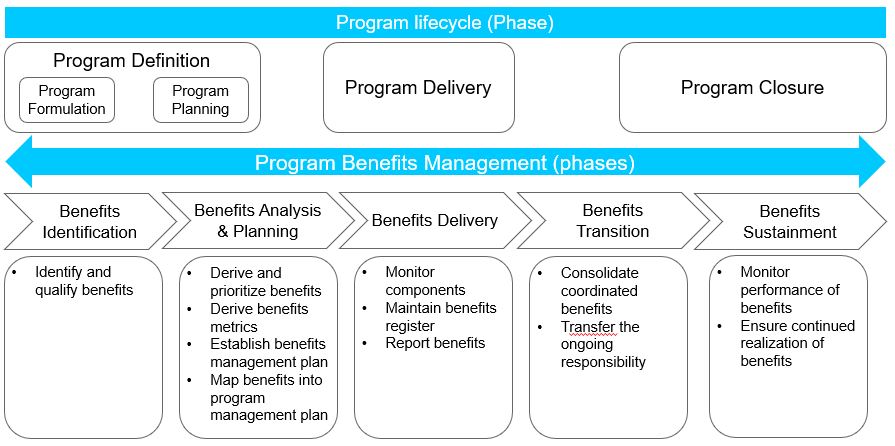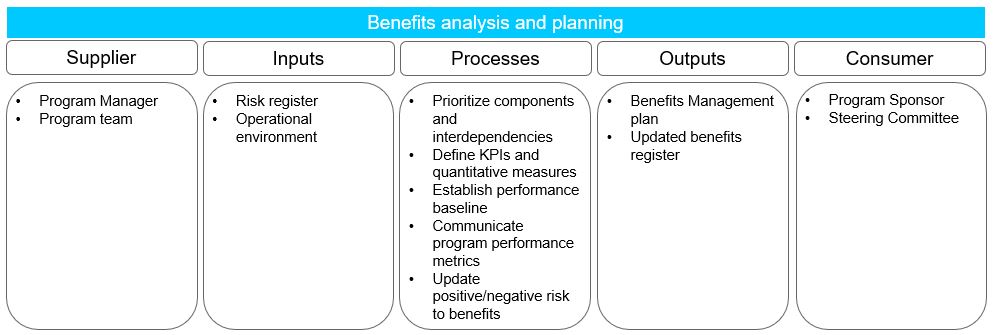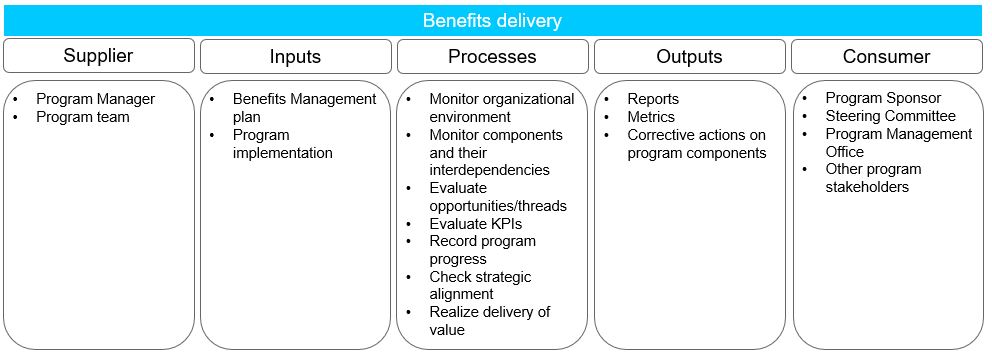This performance domain defined in the Standard for Program Management guide is composed by the following sections you can see below:
 Main concepts reviewed in the guide
Main concepts reviewed in the guide
- Through the program delivery, the program components are planned, developed, integrated and managed, to facilitate the delivery of the intended program benefits.
- Benefits are essential part of program’s deliverables.
- A risk structure for the benefits needs to be establish based on:
- The organization’s risk appetite
- Program’s strategic value
Benefits identification
Business case serves as a formal declaration of the program benefits, the expected delivery and the justification for the resources.
- is developed based on the program business case, the organization’s strategic plan and other relevant program objectives.
- is reviewed with key stakeholders to develop the appropriate performance measures for each benefit.
- is updated during the delivery of the program with the collection of qualitative and quantitative measures.
Benefits planning and analysis
- Quantify the incremental delivery of benefits and plan it in the right place (include the timing).
- Delays on benefits can have negative consequences on the overall program.
- Determine whether the benefits exceeds their control threshold.
- The benefits management plan formally documents the activities necessary for achieving program’s planned benefits. It should include:
- Assumptions linked to each benefit, determine how the benefit will be achieved.
- Link component outputs to planned program outcomes.
- Define metrics and procedures to measure benefits.
- Define roles and responsibilities.
- Define how resulting benefits and capabilities will be transitioned into operations.
- Provide a process for managing the overall benefits management effort.
- The program roadmap should include the incremental benefits delivery.
Benefits delivery
The benefits delivery ensures there is a set of reports or metrics reported to the program.
Key aspects:
- Benefits management is an iterative process.
- Benefits analysis and planning may be continuously revisited as conditions change.
- Corrective actions on program components may be needed in response to information gained from monitoring the organizational environment.
- These corrective actions may require that program components be added, changed or terminated during the benefits delivery phase.
Benefits Transition
The purpose of this phase is to ensure that the program benefits are transitioned to operational areas.
To go through this phase ensures:
- Scope is defined,
- Stakeholders are identified,
- sustainement plans are developed,
- transition is executed,
Key aspects
- The receiving organization is responsible of all preparation processes and activities.
- The receiving organization should have a clear understanding of the capabilities or results to be transitioned and what is required for the entity to successfully sustain the benefits.
- The remaining risks should be monitored.
Benefits sustainment
The purpose of this phase is the ongoing maintenance activities performed beyond the end of the program, to ensure continued generation of the improvements and outcomes delivered by the program.
Key aspects of benefits sustainment
- Benefits must be sustain through operations, maintenance, new components, or other efforts.
- The benefits management plan should define the continuation of benefits delivered during the ongoing activities.
- The program manager is responsible for planning these post-transition activities during the performance of the program.
The activities done during this phase are:
- Planning the necessary recipients to continue monitoring performance.
- Implementing the required change efforts.
- Monitoring the performance of the product/service/capability.
- Monitoring the continued suitability of the product/service/capability.
- Monitoring the continued availability of the product/service/capability.
- Responding to customer inputs.
- Provide on-demand support for the product.
- Planning for and establishing operational support of the product/service/capability.
- Updating technical information.
- Planning the transition
- Planning the retirement and phase-out of the product/service/capability.
- Developing business cases and potential initiation of new projects/programs to respond to operational issues with the deployed product/service/capability.
- Monitoring any outstanding risk affecting the program’s benefit.



Thank you for sharing useful information.